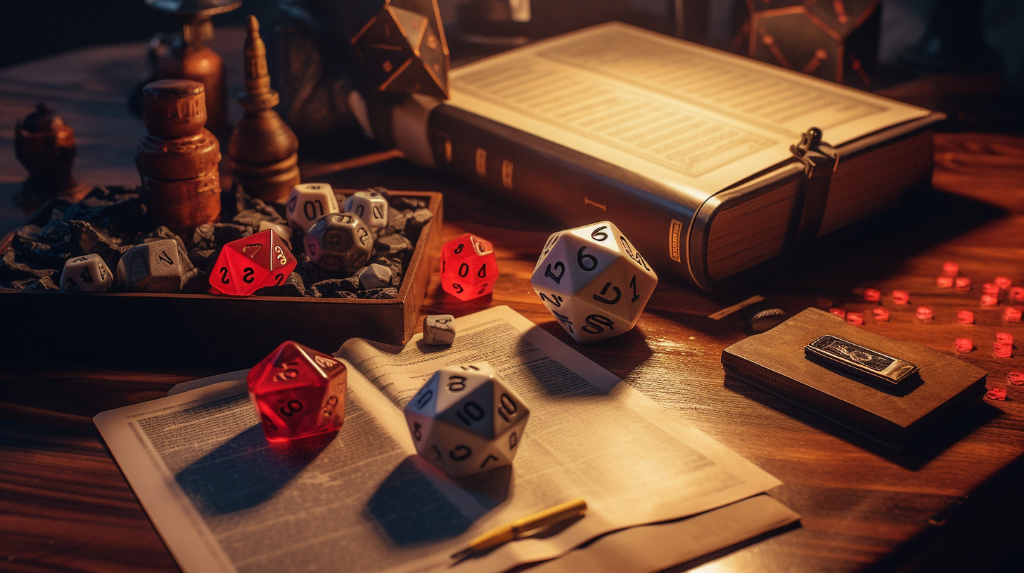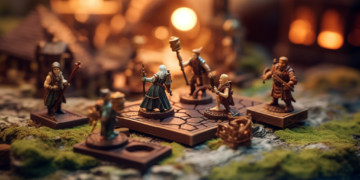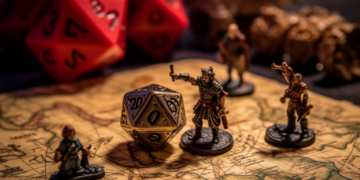
Imagine the power at your fingertips, as you weave the very threads of reality to your will. Picture your wizard, standing amidst the chaos of a brutal battle, calmly conjuring a barricade out of thin air or perhaps a rogue, in the quiet depths of a dungeon, creating a lockpick from a discarded bone. This is the world of Fabrication in Dungeons & Dragons 5e, a spell that can turn the tide of an encounter and open a realm of possibilities for creative gameplay.
Often overlooked in favor of flashier combat spells, Fabrication has the potential to dramatically alter the landscape of an adventure. It is a tool limited only by a player’s imagination and their character’s available resources.
This image captures a moment where Fabrication could be the game-changer – a blacksmith’s forge, ripe with raw materials, or a complex trap that could be disarmed with the right tool, conjured from thin air.
The Essence of Fabrication
Fabrication is more than just a utility spell. It is an embodiment of the world-building aspect of D&D. At its core, Fabrication is about creation. It’s about taking the raw materials of the world and reshaping them to your needs. It’s about the magic that lies not in destruction, but in creation. Does this not evoke the very spirit of D&D, a game built on the foundation of imagination and creativity?
Unleashing the Power of Fabrication
Uttering the incantation, your character reaches into the weave of magic, pulling at the threads that bind the world together. The process of casting a Fabrication spell is a delicate dance. The components required for casting, the intricate hand movements, the concentration – each element plays a crucial role in the spell’s success.
But what happens when the dance is disrupted? A mispronounced word, a forgotten component, or a break in concentration could result in a spell failure. Or worse, the spell could backfire, leading to unpredictable and potentially dangerous outcomes. Isn’t the risk part of the thrill, though? The uncertainty that adds a layer of excitement to every spellcasting attempt?
Types of Objects You can Create with Fabrication
When it comes to the possibilities of Fabrication, the only limit is the imagination of the player. This spell can transform raw materials into an array of objects, varying in complexity and size. So, what can a clever adventurer conjure up?
Crafting Weapons and Tools
Ever found yourself in a tight spot without the right weapon or tool? With Fabrication, you can turn that lump of raw iron into a gleaming, sharp-edged sword, ready to face the horrors lurking in the darkness. Need a lockpick to sneak into the baron’s treasury? A simple twig can be transformed into the perfect tool for the job.
Imagine the surprise on your enemies’ faces when you, seemingly unarmed, pull out a newly crafted weapon from thin air! Or the relief washing over you as the previously locked door swings open, thanks to your handcrafted lockpick. The power of creation is in your hands.
Building Structures and Obstacles
But Fabrication isn’t limited to weapons and tools. Need to cross a dangerous chasm? With a sufficient amount of materials, you can construct a sturdy bridge. Cornered by a horde of goblins? A quick barricade could be your saving grace.
The ability to shape your environment to your advantage can turn the tide of an otherwise dire situation. A well-placed wall or a sudden pit can become a strategic game-changer, shifting the odds in your favor. Who knew that a spell could turn you into a master architect?
Impact of Fabrication on Gameplay
The use of Fabrication can drastically change the dynamics of a game session. It offers creative solutions to problems and challenges the Dungeon Master to adapt to the ever-changing landscape of possibilities. But don’t just take our word for it…
| Scenario | Without Fabrication | With Fabrication |
|---|---|---|
| Locked Door | Search for key or force entry | Create a lockpick and open it quietly |
| Chasm Crossing | Risk jumping across or find a detour | Build a bridge and cross safely |
| Cornered by Goblin Horde | Fight or attempt to escape | Create a barricade and buy time |
| Lacking Weapons | Unarmed combat or retreat | Forge a weapon and fight back |
As you can see, Fabrication can turn a precarious situation into a manageable one, or even a victory. It’s not just about crafting objects, it’s about crafting your own destiny.
Limitations and Potential Drawbacks of Fabrication
In the world of Dungeons & Dragons, spells like Fabrication are not without their limits. Like a double-edged sword, they can be both a boon and a bane. What are these limits, you ask?
Firstly, the spell’s effectiveness is tied to the material you wish to manipulate. Fabrication cannot alter or affect magical or precious materials like mithril, adamantine, or even gemstones. It’s like trying to weave a tapestry with threads of smoke – impossible and frustrating.
Secondly, the complexity of the item you wish to fabricate plays a significant role. You can’t just conjure a fully functioning clockwork mechanism or a detailed portrait out of thin air. The spell requires you to have a deep understanding of the item’s construction. It’s akin to a bard attempting to play an intricate melody without knowing the notes.
Lastly, time is a crucial factor. Fabrication isn’t an instant solution. The more complex your desired item, the longer it takes to fabricate. It’s not a sprint, but a marathon.
But what are the risks? Failed spell casting attempts can lead to wasted components, and in worst-case scenarios, unwanted attention from curious or hostile entities. Imagine trying to craft a key in the midst of a tense stand-off, only for the spell to fail and alert every guard in the vicinity – certainly not an ideal situation.
Mastering Fabrication: Tips and Tricks
Now that you are aware of the limitations and potential drawbacks, how can you maximize the use of Fabrication in your gameplay? Here are some tricks up our sleeve:
- Think out of the box. Use Fabrication to create unexpected items that could turn the tide in your favor. A sudden barricade in a narrow alley, perhaps?
- Combine it with other spells. A Wall of Stone followed by Fabrication could create a fortified stronghold right in the middle of a battlefield.
- Utilize it in unusual environments. Underwater or in the air, Fabrication can be just as useful.
- Practice makes perfect. The more you understand about the items you wish to fabricate, the better your chances of success. Study, learn, and practice.
- Communicate with your Dungeon Master. Their understanding and interpretation of the rules can significantly affect your use of Fabrication. A mutual understanding goes a long way.
The Storytelling potential of Fabrication
With all its intricacies and potential, Fabrication can create a rich tapestry of narratives and challenges. But how?
Imagine a desperate chase through a bustling city, and you, the cunning wizard, using Fabrication to create obstacles to slow down your pursuers. Or perhaps a covert mission where you fabricate a perfect replica of a stolen artifact, deceiving even the most discerning eyes.
Fabrication can also add depth to the game world. It can be the signature spell of a legendary craftsman, leaving his mark on the world through magically created masterpieces. Or it could be the cornerstone of an entire civilization, built on magically fabricated structures and items.
Indeed, Fabrication is not just a tool, but a paintbrush that can color the canvas of your Dungeons & Dragons experience with vibrant and unforgettable strokes.
Notable Uses of Fabrication in Campaigns
Do you recall the time when the rogue crafted a key out of a silver coin to unlock a door, bypassing a deadly trap? Or when the wizard wove a rope out of vines to rescue a fallen companion from a pit? These are but a few examples of how Fabrication can shine in a campaign, turning dire situations into moments of brilliance.
It’s not just about the practical uses, but also the narrative impact. A bard using Fabrication to craft a musical instrument from the bones of a slain beast, a piece that would echo throughout the campaign, adding a haunting undercurrent to their songs.
It’s in these moments that Fabrication truly comes to life, transforming mundane materials into the extraordinary, and shaping the course of adventures in unexpected ways.
- The Key of Opportunity: A rogue uses Fabrication to transform a silver coin into a key, bypassing a deadly trap.
- Rescue Rope: A wizard uses Fabrication to weave a rope out of vines, rescuing a fallen companion from a pit.
- The Bone Instrument: A bard uses Fabrication to craft a musical instrument from the bones of a slain beast, creating a hauntingly beautiful melody.
- The Makeshift Shield: A fighter uses Fabrication to create a shield out of a broken cartwheel, providing crucial defense in a dire moment.
- The Elemental Prism: A sorcerer uses Fabrication to shape a gem into a prism, focusing their elemental magic for a powerful attack.
Final Reflections on Fabrication 5e
As we bring this journey of exploration to a close, it’s clear that Fabrication is more than just a spell. It’s a tool, a weapon, a lifeline, and a canvas for creativity. It’s a testament to the power of imagination and innovation in the world of Dungeons & Dragons.
With its potential to transform the mundane into the extraordinary, to provide solutions to complex problems, and to add depth to storytelling, Fabrication holds a unique place in the arsenal of a D&D player.
Embrace the power of Fabrication. Unleash your creativity. Shape your world. And remember, in the world of D&D, the only limit is your imagination. So, how will you use Fabrication in your next campaign?






